Jump Rings
Jump rings are an integral part of jewelry-making. They hold our designs together and allow us to embellish them in numerous ways. From adding charms to lengthening clasps, jump rings are always needed. They even become the very foundation of designs when used in chain mail. These tips and information will teach you more about the importance of finding the right jump ring for your needs, especially when creating chain mail.
Jump Ring Materials
Jump rings are available in different materials and many different colors. Aluminum jump rings can come in a wide variety of colors and are lightweight. Brass jump rings are economical and plated brass jump rings are available in a variety of metal finishes, like gunmetal, antique silver and more. Bronze and copper jump rings will offer unique shine to your designs and are quite sturdy. For high quality accents, you can choose sterling silver jump rings, silver-filled jump rings or gold-filled options. The type of jump ring you choose will all depend on what you want for your design. If you are trying to add more color to your designs, aluminum jump rings will probably work best. If you want only the finest materials included in your designs, sterling silver is for you.

You can even find jump rings in unique shapes like ovals and triangles. These types of jump rings feature openings on the long sides that make it harder for attached components to slip out of.
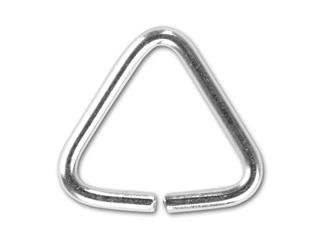
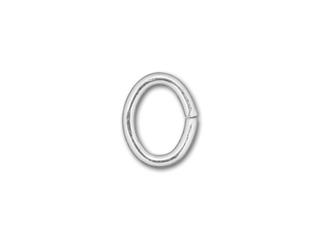
Saw Cut vs. Machine Cut/Cut with Shears
When shopping for jump rings, you may come across certain descriptions: "saw cut," "machine cut" or "cut with shears." These techniques do make a difference in the jump ring! Saw cut jump rings typically have a clean, flush cut which allows the jump ring to close very tightly without any gaps. Cutting jump rings with shears can leave the metal pinched on one or both sides of the cut which can cause a gap and prevent the jump ring from closing properly. Machine cut jump rings can have the same pinched ends and gap. The quality of shear or machine cut jump rings can vary (our example below is more extreme to better show the difference between saw cut and shear cut). Which type you use depends on the application, availability, budget, etc.

Jump Ring Sizes
There are three important measurements to a jump ring. What you end up doing with the jump ring will determine what measurements to consider.

Measuring Jump Rings
Measuring the wire diameter of your jump ring is easy with the right tools. Below are examples of three standard tools that are commonly used in measuring jump rings. We have gathered an American Standard Wire Gauge, a brass millimeter gauge and one pair of calipers. Some digital calipers display measurements both in inches and millimeters.

American Standard Wire Gauge
The American Standard Wire Gauge (AWG), also known as the Brown and Sharpe Standard, is the standard most commonly used in the US and Canada for measuring the diameter of a wire. This wire gauge is round and has notches around the perimeter in graduated sizes to accept the wire. Each notch is a particular size or gauge. The gauges run from zero at the largest end to 30 at the smallest end. Remember that when it comes to gauges, a larger number indicates a thinner gauge and vice versa. Each of the gauge sizes has an equivalent measurement in inches on the other side of the tool.


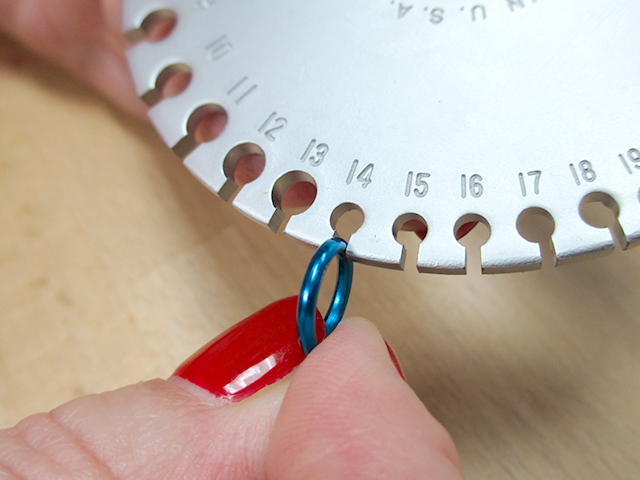
Note: There is also another standard for wire gauges known as the Standard Wire Gauge (SWG) or the British Imperial Standard. If you are following a pattern, it is important to know which standard of measure is called for. The AWG and SWG are not the same.
Sliding Brass Millimeter Gauge
This gauge slides open to measure the object. It displays both inches and millimeters.



Electronic Digital Calipers
Electronic digital calipers slide open for measuring the outside of an object, but also have a section that fits inside an object to get an inside measurement. It displays measurements in either inches or millimeters.
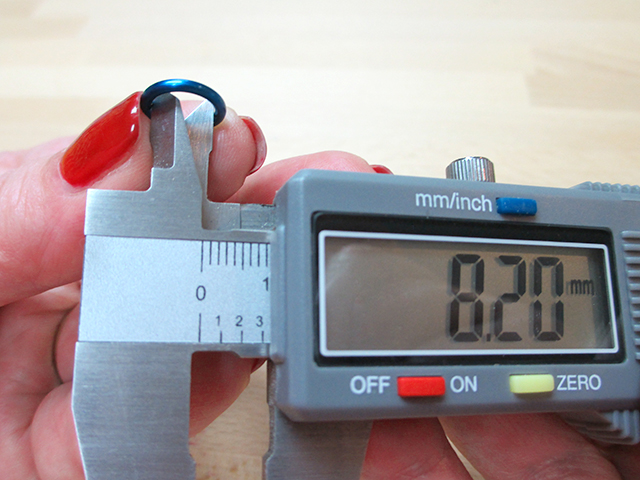


Chain Mail
Now that you've learned more about jump rings, you are probably wondering about how they are used in chain mail. Chain mail consists of jump rings linked together in a pattern that forms a mesh. It can also be called chainmaille. The invention of chain mail is commonly attributed to the Celts and was used in medieval times as part of armor. It continues to be used in the present day in costumes, jewelry and as a component of stab-resistant body armor, cut-resistant gloves for butchers and woodworkers, and even in wetsuits made for defense against shark bites. As you can see, chain mail is used in a wide variety of ways and it's important to get the pattern of jump rings right. One of the most important things to consider when picking jump rings for chain mail is size.
What Size Jump Rings Can I Use?
Size is important to the look and weight of a chain or chain mail design, but the design will really work best when the inner diameter and the wire diameter fall within a particular proportion. This proportion is called Aspect Ratio (AR). Aspect Ratio is the relationship between the inner diameter of the jump ring and the diameter of the wire the jump ring is made out of.
How Do I Find the Aspect Ratio?
Figuring out the Aspect Ratio is simple! All you need are two measurements! To find the Aspect Ratio of a jump ring, divide the inner diameter of the jump ring by the wire diameter of the jump ring, like so:
Inner Diameter ÷ Wire Diameter = Aspect Ratio
or ID/WD=AR
ID: 8.20mm ÷ WD: 1.74 = AR: 4.71
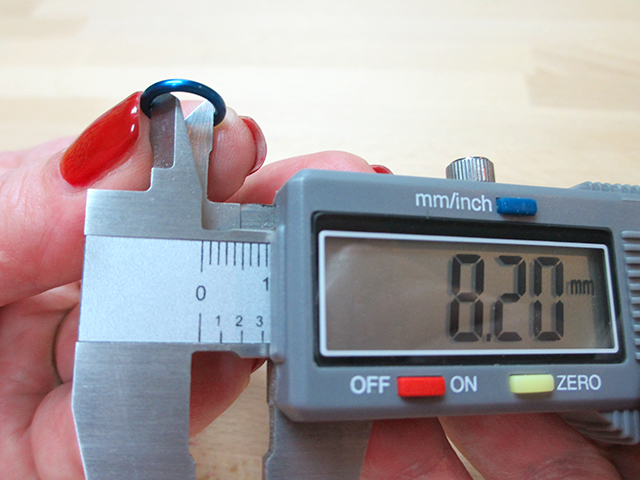
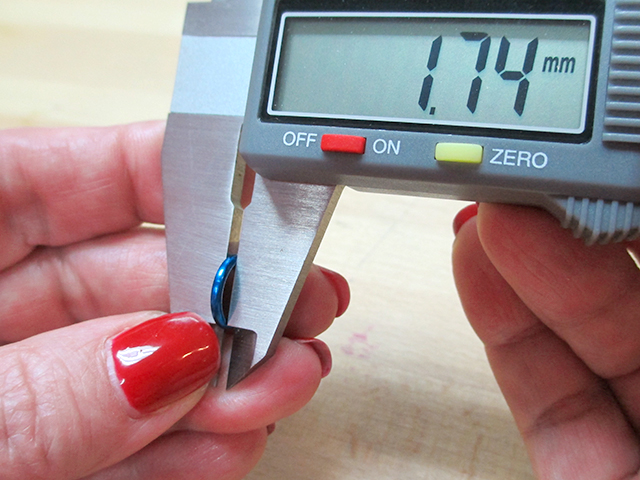
As our example shows, a jump ring with an inner diameter of 8.20mm and a wire diameter of 1.74mm would have an Aspect Ratio of 4.71.
So, if a pattern says to use jump rings with an Aspect Ratio of 3.2 and higher, then this size jump ring will work. If the pattern says to use jump rings with an Aspect Ratio of 3.2 to 4.2, then this size jump ring will not work. If the inner diameter of the jump ring is too big or the wire diameter is too small in proportion to each other, the weave of the chain or chain mail will end up too loose. If the inner diameter is too small or the wire diameter is too large, the weave will end up too tight or you might not be able to link the jump rings together.
Note: Wire gauge and wire diameter are not the same. If the measurement you have is for a gauge, you will need to convert that gauge to inches or millimeters, depending on which unit of measure the inner diameter is measured by. Take a look at our wire gauge conversion chart.
By understanding the Aspect Ratio, you can also alter a pattern. Let's say you like a particular design, but the jump rings used were large and bulky and you want something finer. As long as the Aspect Ratio of the jump rings is the same or falls within the range the pattern calls for, you can use different sizes of jump rings.

The Aspect Ratio range of 3.2 to 4.2 is best for the Byzantine style weave, shown above in two different sizes. The larger version uses jump rings with a 6.50mm ID and a 1.58mm WD. The AR for this version is 4.11. The smaller version uses jump rings with a 5.02mm ID and a 1.22mm WD. The AR for this version is also 4.11. They both fall within the recommended Aspect Ratio range.
GLOSSARY
- ID (Inner Diameter): The inside diameter of a jump ring
- OD (Outer Diamter):
- The outside diameter of a jump ring
- WD (Wire Diameter): The diameter of the wire used in a jump ring
- AR (Aspect Ratio): AR = ID / WD
Wire Gauge: See the two standards below
- AWG: American Wire Gauge, also known as the Brown and Sharpe Standard
- SWG: Standard Wire Gauge, also known as Imperial Standard
The Aspect Ratio range of 3.2 to 4.2 is best for the Byzantine style weave, shown above in two different sizes. The larger version uses jump rings with a 6.50mm ID and a 1.58mm WD. The AR for this version is 4.11. The smaller version uses jump rings with a 5.02mm ID and a 1.22mm WD. The AR for this version is also 4.11. They both fall within the recommended Aspect Ratio range.
Jump Ring Tutorials
You've learned so much about jump rings and chain mail! Now it's time to jump in and try it in your designs. You can even make your own jump rings. Take a look at our Design Studio for ideas featuring jump rings and chain mail!
